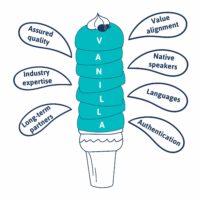Choosing the right translation service provider for your business: An introduction for marketers
If you are a marketer who’s new to sourcing translation services, choosing the right provider can seem like a daunting task. The translation industry is hugely fragmented in terms of service offering as well as pricing, which doesn’t make your job any easier. Who do you want to work with: individual freelance translators or an agency? What kind of translation do you need: machine translation, AI translation, professional human translation, transcreation or copywriting? And how do you compare translation providers with each other to choose the right one for you: what does good look like?
Why it’s not all about the price
As a newcomer to purchasing translations, when all the offers look the same to you, how do you decide? We often find that marketers tend to focus on the price as the main driving factor for choosing a translation provider. And it’s understandable: with all things seemingly equal, the price tag is the one factor that’s clear and easy to understand. And entering a new market is risky, so keeping initial costs low is seen as a sensible way to manage that risk, right? Not quite.
Choosing a translation provider is a bit like choosing your next favourite pair of shoes. You’ve probably bought a cheap pair of shoes in the past that looked great on the shelf. They were super cheap, but hey, shoes are shoes, how bad can it be? You wore them a few times. They weren’t super comfortable and after a week or two the sole started to come away or the fabric started to tear. And after the shoes inevitably completely fell apart and you realised the short-term saving was a false economy, you promised yourself that the next time you bought a pair of shoes, you would spend a bit more, take a closer look at their finish, perhaps read some online reviews, and maybe even consciously choose an eco-friendly or ethical brand. You promised yourself that your next favourite pair of shoes would be long-term companions for your feet.
The same principle applies to translation services. To help your brand succeed internationally, you need a solid translation partner that supports you, not just for the initial sprint of launching a website, for example, but to run the whole marathon with you – consistently reliable, consistently delivering great quality, consistently adjusting and scaling alongside you as your international expansion takes flight.
Imagine what could happen if you were to choose your translation provider on price alone. Sure, you would make a short-term saving, but if the translation is bad, your brand could be cast in a negative light and the costs of fixing a bad translation, as well as your brand reputation, could be huge. In other words, a bad translation could really put the kibosh on your international marketing – which is the last thing you need when you are just launching into a new market.
How to choose the right translation provider for your business
So how do you find the right translation provider for your business and your brand? Well, just as with any other service provider, you need to assess translation providers on more than just price. You check out their credentials. You check out their capabilities. You check whether they are a good cultural fit for you. You check if they can scale up as your demand grows.
To help you structure your assessment of potential translation partners, we came up with an easy to remember acronym – VANILLA, which stands for value alignment, assured quality, native speakers, languages, long-term partners and authentication. Let’s take a closer look at each of these elements.

Value alignment
In the same way we are drawn to certain brands or companies in our personal lives because they share our personal values, choosing a translation partner should be based on shared values, too. A good translation partner will essentially become an extension of your own team, so you will want to work with people that share your values to ensure a smooth and joyful long-term collaboration. Values can be anything from expectations around what good customer service looks like, to bigger picture things like social and environmental performance. Just as an example, our own core values here at AJT are that we are ethical, passionate, nurturing, transparent and collaborative. Our focus is on looking after our people and our planet, and carefully balancing that with profitability. So we would be a great fit for a sustainable clothing manufacturer, but not for a fast-fashion label. Think about the values that drive your own company, and check that there is a natural overlap with your translation provider.
Assured quality
You want to be sure that the translations that are delivered to you are error-free and ready for print and/or publishing. For marketing translations in particular, the translations should ideally be proofread by a second translator, who is also a native speaker of the target language. Different providers have different names for their quality assurance steps: proofreading, editing and review are just some examples. It’s not always immediately clear from looking at a sales brochure or proposal document what these services actually entail. Is the review a simple quality assurance check carried out by a non-native speaker that focuses only on non-linguistic checks (formatting, numbers, has everything been translated, etc)? Or is the review a careful proofreading step carried out by a second native speaker that includes both linguistic and non-linguistic checks? The difference is really important. Ask your potential translation providers how they assure the quality of their work and don’t be afraid to dig a little deeper to make sure you’re comparing like for like when going through quotes from different companies.
Native speakers
Marketing translations should generally be carried out by professional translators who are native speakers of the language they translate into. If you are localising your website for the German market, for example, professionally trained translators who are native speakers of German and who know the German language and culture inside and out should translate your content. Someone who is fluent in German just isn’t enough. After all, you want to make sure your translated copy reads like a locally produced text rather than a translation. Nothing, no matter how small, should distract your German readers from engaging with your content, so your copy needs to ‘feel native’. Make sure to ask your potential providers who will be working on your content.
Industry expertise
You will want to work with translation providers who are knowledgeable about your industry and who are familiar with the kind of products and services you provide, as well as the industry-specific terminology that is used. Your new translation provider should be able to demonstrate specific experience in your industry sector. Be mindful that translation providers might not always be able to disclose actual client names as examples because of confidentiality and non-disclosure agreements but they should still be able to tell you more about the types of clients they work for to show they are a good fit for you. Here at AJT, for example, we have demonstrable experience in B2B marketing translations for tech companies and B2C marketing translations for consumer brands, but we wouldn’t be a good fit for heavily legal translations, patent translations or life sciences translations. We make this clear at the discovery stage of speaking to potential new clients, so don’t be afraid to ask a translation company what their strengths and weaknesses are, otherwise you could end up with a ‘Jack of all trades, master of none’. And your brand deserves a master.
Languages
What languages do you need right now? What languages might you need further down the line? The languages you need to translate into will have an impact on who you can work with. A freelance translator can typically only support you with translations into one language – their native language. If you are looking to translate your marketing assets into several languages at the same time, you might instead consider a translation company who can localise into several languages at the same time. We generally recommend choosing a regional language provider who is based in the region you are expanding into rather than a super agency that translates all the world’s languages without a specialisation in any particular region. For example, you might want to choose a European language specialist for the European market, an African language specialist for the African market, and so on. This way you can ensure that the whole company, not just the individual translators, live and breathe the culture of your target markets, and provide a service that’s really tailored for you.
Long-term partners
Finding a trustworthy, reliable and value-aligned translation provider takes time. And ideally you don’t want to have to go through that process very often. So it’s sensible to look for a partner that can support you, not just right now, but for years to come.
Capability and scalability are one consideration: What languages will you need? How quickly do you need to localise for each market? How much will you need to translate? Will you need technology such a translation management system or plugins and integrations? You are looking for a translation provider that can scale along with you as you expand internationally, so you will need to include questions around these capabilities in your research.
Another consideration are the stipulations your company might have around which suppliers you can work with. For example, is your company a Living Wage employer and would therefore prefer to work with suppliers who are also Living Wage employers? Does your company have requirements around ISO standards? Is your company working towards an accreditation (such as B Corp) that might have an impact on which providers it can work with – not just now, but also in the future?
Localisation isn’t a one-off effort – it’s an ongoing, long-term process, so it’s important to not just focus on the here and now, but to look more broadly at where your company is heading to make sure the translation partner you choose now will still be a good fit in one, two or five years’ time.
Authentication
And finally, let’s talk about due diligence. Before you start assigning work to a new provider, it’s a good idea to first verify that the company is legitimate by carrying out a few simple checks. At the very least, you can search for their company name online, check third party review sites like Trust Pilot and go to Companies House (in the UK) to verify that they are a legitimate business. In the UK, if a company is a member of the industry associations ITI (Institute of Translation and Interpreting) or ATC (Association of Translation Companies), you can rest assured that they have been carefully vetted and adhere to the strict professional standards of the translation industry. You can ask for references or testimonials from other customers that the company has worked with. You can ask for proof of any accreditations that the company advertises on their website. You can even carry out a credit check. It might not be necessary to do all these things, but it always makes good business sense to carry out your due diligence checks before you start your collaboration.
The right translation partner will add real value to your team and help you to execute your localisation strategy in the best possible way. So when it comes to making the final decision about who you would like to entrust with your marketing translations, remember VANILLA and make sure you compare your potential translation partners objectively, check their credentials carefully, and choose your partner wisely.
This article was originally published in September 2021 and has since been updated to include links to other articles on our website.
